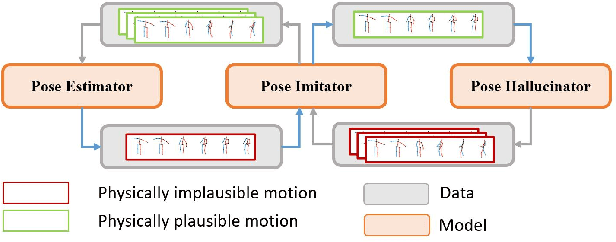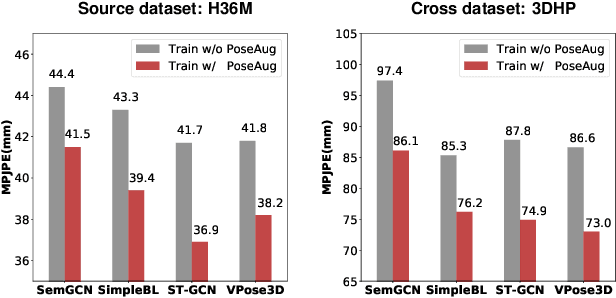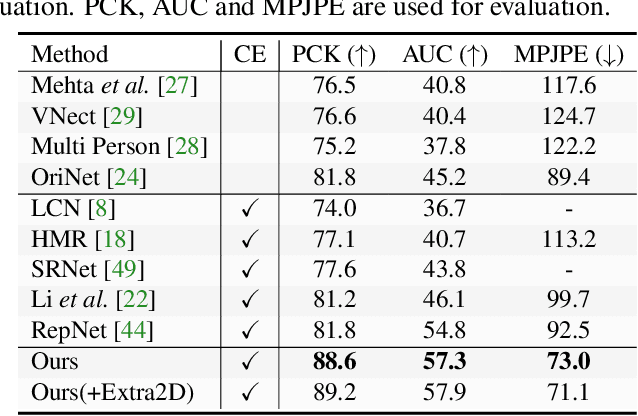Kehong Gong
MotionMix: Weakly-Supervised Diffusion for Controllable Motion Generation
Jan 24, 2024Abstract:Controllable generation of 3D human motions becomes an important topic as the world embraces digital transformation. Existing works, though making promising progress with the advent of diffusion models, heavily rely on meticulously captured and annotated (e.g., text) high-quality motion corpus, a resource-intensive endeavor in the real world. This motivates our proposed MotionMix, a simple yet effective weakly-supervised diffusion model that leverages both noisy and unannotated motion sequences. Specifically, we separate the denoising objectives of a diffusion model into two stages: obtaining conditional rough motion approximations in the initial $T-T^*$ steps by learning the noisy annotated motions, followed by the unconditional refinement of these preliminary motions during the last $T^*$ steps using unannotated motions. Notably, though learning from two sources of imperfect data, our model does not compromise motion generation quality compared to fully supervised approaches that access gold data. Extensive experiments on several benchmarks demonstrate that our MotionMix, as a versatile framework, consistently achieves state-of-the-art performances on text-to-motion, action-to-motion, and music-to-dance tasks. Project page: https://nhathoang2002.github.io/MotionMix-page/
Priority-Centric Human Motion Generation in Discrete Latent Space
Aug 30, 2023Abstract:Text-to-motion generation is a formidable task, aiming to produce human motions that align with the input text while also adhering to human capabilities and physical laws. While there have been advancements in diffusion models, their application in discrete spaces remains underexplored. Current methods often overlook the varying significance of different motions, treating them uniformly. It is essential to recognize that not all motions hold the same relevance to a particular textual description. Some motions, being more salient and informative, should be given precedence during generation. In response, we introduce a Priority-Centric Motion Discrete Diffusion Model (M2DM), which utilizes a Transformer-based VQ-VAE to derive a concise, discrete motion representation, incorporating a global self-attention mechanism and a regularization term to counteract code collapse. We also present a motion discrete diffusion model that employs an innovative noise schedule, determined by the significance of each motion token within the entire motion sequence. This approach retains the most salient motions during the reverse diffusion process, leading to more semantically rich and varied motions. Additionally, we formulate two strategies to gauge the importance of motion tokens, drawing from both textual and visual indicators. Comprehensive experiments on the HumanML3D and KIT-ML datasets confirm that our model surpasses existing techniques in fidelity and diversity, particularly for intricate textual descriptions.
TM2D: Bimodality Driven 3D Dance Generation via Music-Text Integration
Apr 05, 2023Abstract:We propose a novel task for generating 3D dance movements that simultaneously incorporate both text and music modalities. Unlike existing works that generate dance movements using a single modality such as music, our goal is to produce richer dance movements guided by the instructive information provided by the text. However, the lack of paired motion data with both music and text modalities limits the ability to generate dance movements that integrate both. To alleviate this challenge, we propose to utilize a 3D human motion VQ-VAE to project the motions of the two datasets into a latent space consisting of quantized vectors, which effectively mix the motion tokens from the two datasets with different distributions for training. Additionally, we propose a cross-modal transformer to integrate text instructions into motion generation architecture for generating 3D dance movements without degrading the performance of music-conditioned dance generation. To better evaluate the quality of the generated motion, we introduce two novel metrics, namely Motion Prediction Distance (MPD) and Freezing Score, to measure the coherence and freezing percentage of the generated motion. Extensive experiments show that our approach can generate realistic and coherent dance movements conditioned on both text and music while maintaining comparable performance with the two single modalities. Code will be available at: https://garfield-kh.github.io/TM2D/.
PoseTriplet: Co-evolving 3D Human Pose Estimation, Imitation, and Hallucination under Self-supervision
Mar 29, 2022



Abstract:Existing self-supervised 3D human pose estimation schemes have largely relied on weak supervisions like consistency loss to guide the learning, which, inevitably, leads to inferior results in real-world scenarios with unseen poses. In this paper, we propose a novel self-supervised approach that allows us to explicitly generate 2D-3D pose pairs for augmenting supervision, through a self-enhancing dual-loop learning framework. This is made possible via introducing a reinforcement-learning-based imitator, which is learned jointly with a pose estimator alongside a pose hallucinator; the three components form two loops during the training process, complementing and strengthening one another. Specifically, the pose estimator transforms an input 2D pose sequence to a low-fidelity 3D output, which is then enhanced by the imitator that enforces physical constraints. The refined 3D poses are subsequently fed to the hallucinator for producing even more diverse data, which are, in turn, strengthened by the imitator and further utilized to train the pose estimator. Such a co-evolution scheme, in practice, enables training a pose estimator on self-generated motion data without relying on any given 3D data. Extensive experiments across various benchmarks demonstrate that our approach yields encouraging results significantly outperforming the state of the art and, in some cases, even on par with results of fully-supervised methods. Notably, it achieves 89.1% 3D PCK on MPI-INF-3DHP under self-supervised cross-dataset evaluation setup, improving upon the previous best self-supervised methods by 8.6%. Code can be found at: https://github.com/Garfield-kh/PoseTriplet
PoseAug: A Differentiable Pose Augmentation Framework for 3D Human Pose Estimation
May 06, 2021



Abstract:Existing 3D human pose estimators suffer poor generalization performance to new datasets, largely due to the limited diversity of 2D-3D pose pairs in the training data. To address this problem, we present PoseAug, a new auto-augmentation framework that learns to augment the available training poses towards a greater diversity and thus improve generalization of the trained 2D-to-3D pose estimator. Specifically, PoseAug introduces a novel pose augmentor that learns to adjust various geometry factors (e.g., posture, body size, view point and position) of a pose through differentiable operations. With such differentiable capacity, the augmentor can be jointly optimized with the 3D pose estimator and take the estimation error as feedback to generate more diverse and harder poses in an online manner. Moreover, PoseAug introduces a novel part-aware Kinematic Chain Space for evaluating local joint-angle plausibility and develops a discriminative module accordingly to ensure the plausibility of the augmented poses. These elaborate designs enable PoseAug to generate more diverse yet plausible poses than existing offline augmentation methods, and thus yield better generalization of the pose estimator. PoseAug is generic and easy to be applied to various 3D pose estimators. Extensive experiments demonstrate that PoseAug brings clear improvements on both intra-scenario and cross-scenario datasets. Notably, it achieves 88.6% 3D PCK on MPI-INF-3DHP under cross-dataset evaluation setup, improving upon the previous best data augmentation based method by 9.1%. Code can be found at: https://github.com/jfzhang95/PoseAug.
 Add to Chrome
Add to Chrome Add to Firefox
Add to Firefox Add to Edge
Add to Edge